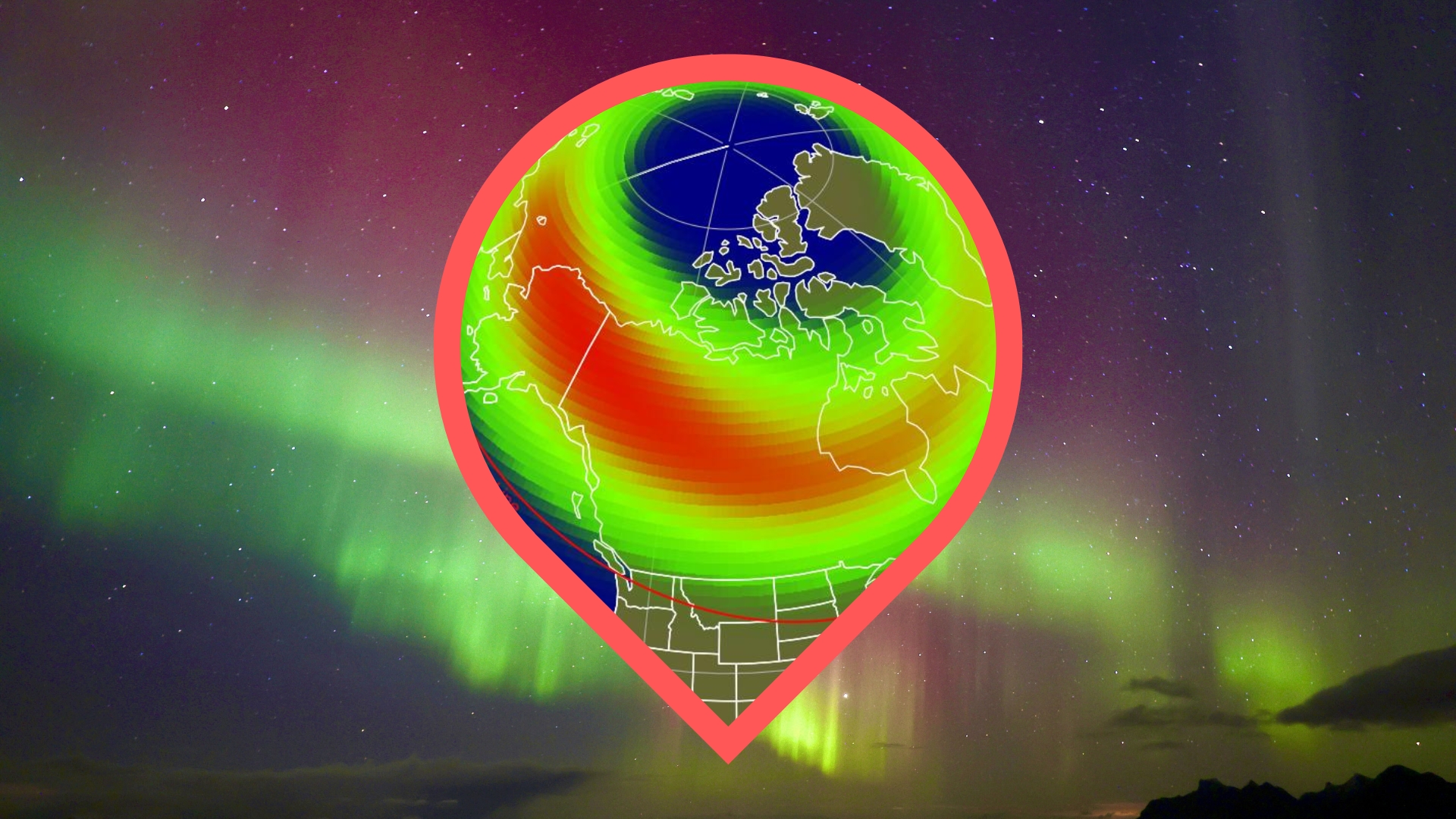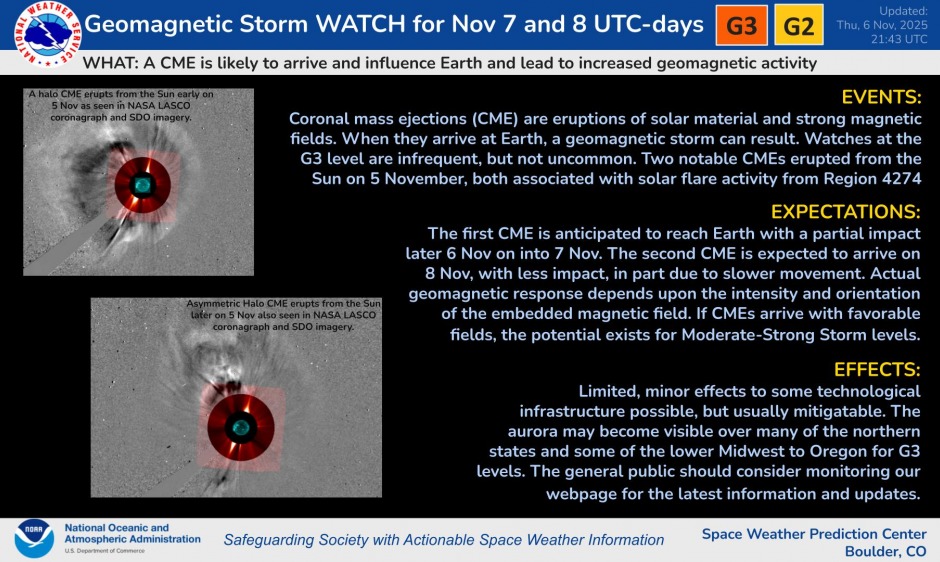Northern lights may be visible in 10 US states on Nov. 7
Auroras may be visible from Alaska to Michigan as geomagnetic storm conditions are predicted to continue tonight.

A geomagnetic storm is ongoing as Earth continues to be buffeted by a series of solar eruptions and fast solar wind, with strong (G3) conditions expected to persist through tonight (Nov. 7). That means the northern lights could once again put on a spectacular display across parts of Europe, Canada and the northern U.S.
Earlier today (Nov. 7), the anticipated arrival of a coronal mass ejection (CME) launched with the M7.4 flare on Nov. 5 was detected by spacecraft positioned at Lagrange Point 1 (L1), roughly 1 million miles (1.5 million kilometers) from Earth. "The leading edge of a CME, presumably from the M7.6 flare, reached L1 just before 5h UTC," aurora chaser Jure Atanackov wrote on X. "Solar wind speed increased to ~800 km/s, Bt increased to ~17 nT. Bz has been variable so far, reaching everything between +16 and -16 nT. If it manages to stabilize at strongly negative values for some time, then we will see a rapid increase in geomagnetic activity."
NOAA's Space Weather Prediction Center has a G3-G2 storm watch in place for Nov. 7 and Nov. 8 as Earth experiences continued impacts from multiple CMEs and a fast solar wind stream from a coronal hole.
Where and when can you see the northern lights tonight?
According to NOAA's Kp index forecast, geomagnetic storming is expected to last between Nov 7 and Nov. 8.
Based on the latest NOAA aurora forecast map, the following 10 U.S. States appear fully or partially above the aurora view line:
- Alaska
- Montana
- North Dakota
- Minnesota
- Maine
- Washington
- Idaho
- South Dakota
- Wisconsin
- Michigan
But remember, that auroras are highly unpredictable, so even if you're within the view line, you'll still need cloud-free skies, minimal light pollution, a clear view northward and a little bit of luck to catch the show.
Northern Hemisphere aurora forecast courtesy of the Met Office
How to see the northern lights where you live
If you're in one of the 10 U.S. states listed above, here are some tips for catching a glimpse of the display.
Breaking space news, the latest updates on rocket launches, skywatching events and more!
- Head to a dark location far from city lights and light pollution.
- Find a north-facing view with a clear horizon.
- Look up around midnight to 2 a.m. local time, but keep watch as soon as skies darken.
- Be patient. Auroras often come in waves and can appear faint at first.
We recommend downloading a space weather app that provides aurora forecasts based on your location. One option I use is "My Aurora Forecast & Alerts," available for both iOS and Android. However, any similar app should work well. I also use the "Space Weather Live" app, which is available on iOS and Android, to get a deeper understanding of whether the current space weather conditions are favorable for aurora sightings.
What's causing the aurora activity?
Tonight’s aurora display is being driven by the impact of a CME launched by an M7.4 solar flare on Nov. 5 from sunspot region AR4274 — a large, magnetically complex active region now rotating into better view of Earth. The CME, which had been traveling at speeds of 1,100 to 1,400 km/s (2.5–3.1 million mph), arrived at Earth early on Nov. 7 UTC, sharply increasing solar wind speed and magnetic field strength.
The current G3 (Strong) geomagnetic storm watch remains in effect as more solar material is expected to arrive through Nov. 8, including a second CME launched by an M8.6 flare later on Nov. 5. Meanwhile, fast solar wind from a nearby coronal hole continues to enhance the disturbance.
NOAA and the U.K. Met Office both forecast elevated activity to continue through Nov. 8–9, with the strongest geomagnetic conditions likely on Nov. 7, followed by moderate storming on Nov. 8 and gradually easing conditions on Nov. 9.
What else could be coming?
Region AR4274 remains highly active and continues to rotate to face Earth. Multiple significant flares have erupted from this region over the past 48 hours, some with associated CMEs still being analyzed. The U.K. Met Office warns that elevated geomagnetic activity could continue into the weekend and even into Nov. 9, especially if additional CMEs are launched in Earth's direction.
If you're an aurora enthusiast, keep your camera batteries charged; the show may be far from over.
Editor's note: This article was originally published on Nov. 6, 2025, and has since been updated on Nov. 7 at 5:30 a.m. EST (1030 GMT) to reflect NOAA and UK Met Office forecasts issued Nov. 7, including the confirmed CME impact and ongoing possible G3 storming. A quote from aurora chaser Jure Atanackov has also been added.

Daisy Dobrijevic joined Space.com in February 2022 having previously worked for our sister publication All About Space magazine as a staff writer. Before joining us, Daisy completed an editorial internship with the BBC Sky at Night Magazine and worked at the National Space Centre in Leicester, U.K., where she enjoyed communicating space science to the public. In 2021, Daisy completed a PhD in plant physiology and also holds a Master's in Environmental Science, she is currently based in Nottingham, U.K. Daisy is passionate about all things space, with a penchant for solar activity and space weather. She has a strong interest in astrotourism and loves nothing more than a good northern lights chase!
You must confirm your public display name before commenting
Please logout and then login again, you will then be prompted to enter your display name.


